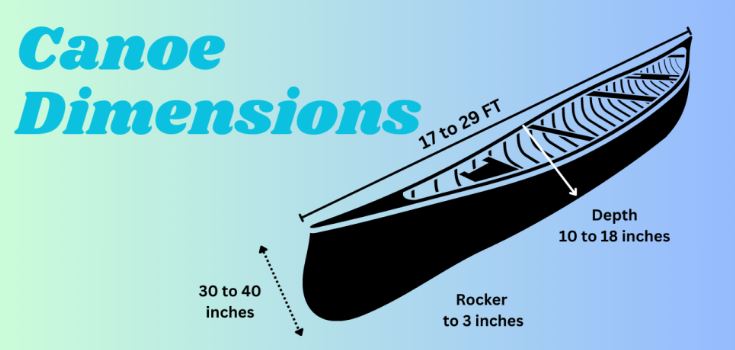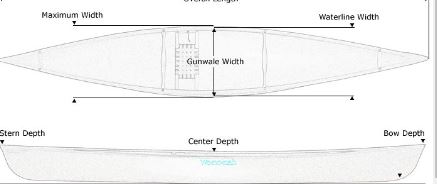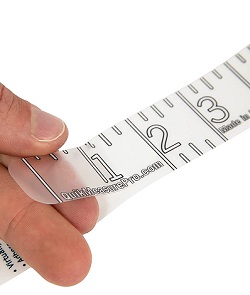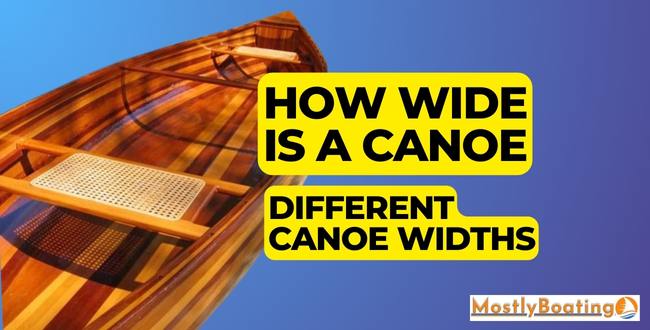Choosing the right size canoe is one of the most important considerations when beginning canoeing. With factors like transporting a canoe and storing it, considering the right canoe dimensions is crucial.
But how wide is a canoe, exactly?
With different types of canoes, there are different width dimensions to consider. For instance, a narrow canoe is 33 inches wide, while a standard canoe width ranges between 34-37 inches, and an extra wide canoe can be as wide as 38 inches.
The various width measuring terms like the BOL (Beam Overall) or BWL (Beam Waterline) are what help determine these dimensions of a canoe.
Now to help you understand the different widths of a canoe, this detailed guide will unfold everything you need to know about understanding how wide is a canoe.
So, let’s dive into the details, shall we?
How Wide is a Canoe?
Before we begin exploring different aspects of the weight and size of a canoe, let’s get the answers to some basic questions about a canoe’s width and weight.
Between the BWL Beam and the BOA Beam, Which One is Accurate?
Regarding BOA (Beam Overall) and BWL (Beam Waterline), BWL is more accurate and crucial because it determines the depth of a canoe inside the water. In contrast, BOA is the overall ship or canoe width measured at the widest nominal waterline point.
Which One to Choose Between Wide or Narrow Canoe for Beginners?
Canoes with a bigger volume or surface area are suitable for carrying more gear and/or more people because the breadth of a canoe influences its stability. Shorter canoes, on the other hand, might be slower and more difficult to glide in for beginners. As a result, broader canoes are a better and more stable option for beginners.

Does the Width of the Canoe Affect Weight Limit and Performance?
Yes, it does. As a rule of thumb, a wider canoe can support more weight. Likewise, the wider a canoe is, the more weight it can hold while gliding easily.
Are wide inflatable canoes also have good stability?
Yes, similar to regular canoes, a wider inflatable canoe will have good stability as well, just make sure that it is made from a sturdy material.
Canoe Width Basics Explained:
Below is a detailed table explaining all aspects that help determine the ideal canoe width:
| Category | Best Use | BWL (Beam Waterline) | BOA (Beam Overall) | Length | Price Range | Weight Capacity | Stability |
| Narrow | Recreational, Solo Paddling | Up to 30″ | 33″ – 35″ | Up to 12′ (365 cm) | $400 – $1,200 | Up to 300 lbs (136 kg) | Lower initial stability |
| Standard | Recreational, Touring, Fishing | 31″ – 35″ | 36″ – 38″ | 13′ – 16′ (396-487 cm) | $500 – $1,500 | 400-800 lbs (181-363 kg) | Balanced stability |
| Wide | Fishing, Family/Group Canoeing | 36″ – 39″ | 39″ – 42″ | 14′ – 18′ (426-548 cm) | $700 – $2,500 | 600-1,200 lbs (272-544 kg) | Higher stability |
| Extra Wide | Family/Group Canoeing, Expedition | 40″ or more | 43″ or more | 15′ – 20′ (457-609 cm) | $900 – $3,500 | 800-1,500 lbs (363-680 kg) | Maximum stability |
| Small Solo | Solo Paddling, Whitewater | 28″ – 32″ | 33″ – 35″ | Up to 12′ (365 cm) | $400 – $1,500 | Up to 350 lbs (159 kg) | Dependent on design |
| Medium Tandem | Recreational, Touring, Family Canoeing | 33″ – 37″ | 36″ – 39″ | 13′ – 16′ (396-487 cm) | $700 – $2,500 | 500-900 lbs (227-408 kg) | Balanced stability |
| Large/Family | Family Canoeing, Group Outings | 38″ – 42″ | 40″ – 44″ | 14′ – 18′ (426-548 cm) | $800 – $3,000 | 700-1,200 lbs (318-544 kg) | Higher stability |
| Square Stern | Fishing, Recreational, Small Outboard | 38″ – 42″ | 43″ or more | 14′ – 18′ (426-548 cm) | $800 – $2,500 | 500-1,000 lbs (227-454 kg) | Balanced stability |
| Saranac 146 | Recreational, Family Canoeing | 33.75″ | 36″ | 14’6″ (442 cm) | $700 – $1,000 | 700-750 lbs (318-340 kg) | Balanced stability |
| Journey 156 | Touring, Family Canoeing | 35″ | 37″ | 15’6″ (472 cm) | $1,000 – $1,500 | 650-800 lbs | Balanced |
Beam
So what is a beam in a canoe? Don’t worry, it’s not a scientific term. Instead, a ship’s beam is its width across its middle. Now, there are different aspects of a beam, including
- Beam at the waterline (BWL), which is the maximum width where the hull meets the water’s surface
- The beam of the hull (BH), which only comprises permanently fixed elements of the hull
- Maximum beam (BMAX), which is the distance between planes going through the outer sides of the ship.

When understanding the different types of beams, it’s important to know that the greater the beam of a ship or boat, the greater its initial stability. However, in the case of a capsize, the greater the energy required to right the vessel from its inverted posture.
BOA (Beam Overall)
Canoe width is typically called the “beam overall.” The width is measured across the top of the gunwales (side rails) of the canoe, where it is the most spacious.
BWL Beam
BWL, or the waterline beam of a canoe, is its broadest point, where the canoe’s sides meet.
Now, the second measurement—width or beam at the waterline—is more relevant. Because it shows how much of your canoe is submerged. That’s significant because your canoe’s water-contact area affects how hard it is to paddle.
Gunwale Width
The rim that extends around the top edge of a canoe is called the gunnel (or gunwale).
Simply put, the gunwale is the top edge of a canoe that has been enlarged and strengthened with wood, plastic, or aluminum to support the thwarts. The typical width of a canoe’s gunwales is 1-2 inches.
Waterline Width
The waterline width is also known as the waterline beam (mentioned earlier). This width helps evaluate how much a canoe is inside the water.

Maximum Width
Maximum width is the overall width of a canoe. Now, although a canoe’s size or canoe dimensions depend mainly on the purpose, type, and design of the boat, these lightweight boats are usually 14-17 feet long, with their widest point ranging between 34-37 inches.
Chine Width
The chine is among the parts of canoe where the floors transition into the wall. While the shape of this type of transition in a canoe varies, a canoe has a hard or soft chine. Now, a hard chine is sharp and angular, whereas a soft chine is softer and more rounded.
Keel Width
A canoe’s keel is a rib-like projection at the bottom, located between its pointed nose and its pointed tail. The canoe’s keel ensures a steady course through the water.
The keel width of a canoe is the distance across the middle (centerline) of the boat from bow to stern.
Rocker
Another worth considering as part of a canoe is the rocker. How much the keel line of the canoe is curved from the bow to the stern is referred to as its rocker. Having said that, canoes with a lot of rocker will be able to turn rapidly but won’t track as straight as one with less rocker since less of the hull will be submerged in the water.
Tumblehome
Last but not least, a canoe’s tumblehome can be recognized by its reduced breadth across the gunwales compared to its width along the waterline. Moreover, the tumblehomes on boats can make them easier to paddle steadily.
Whether you want to sleep in a canoe or go for fishing, every adventure on this vessel directly links with it’s width. Supposedly, you’re getting into a canoe which is narrow, then it may shake in the water resulting in capsizing, or you may even fall in the water.
Difference Between Initial Stability and Secondary Stability
Just as it sounds, initial stability refers to how steady your canoe seems right after you take it into the water and climb inside. Secondary or final stability, on the other hand, refers to the canoe’s steadiness as it moves forward in the water, including its resistance to capsizing even when tipped on its side.
Understanding Gunwale Width vs. Waterline Width
There are noticeable differences between a canoe’s gunwale width and waterline width. The gunwale, or the top edge of the canoe, is an additional piece of wood, plastic, or aluminum that aids in the vessel’s stability and support. Moreover, the gunwale, usually only an inch or two wide, is an important structural component of a canoe.
On the other hand, the waterline beam (BWL) is the widest part of the canoe, where the two sides meet. This dimension impacts the canoe’s buoyancy and stability in the water, making for a more secure and comfortable journey. When it comes to improving the canoe’s performance on the water, the waterline width is just as important as the gunwale width.
If you don’t want to sacrifice the canoeing speed due to greater width, but still stability is your focus as well. Then, you can also install DIY canoe stabilizer, though it can add a little weight but you can opt for lightweight material.
Different Canoes Widths Available Out There
With different types of canoes available today, you can explore various ratios of wide canoes. Each of the width ratios determines the category of a canoe, and also answer how much does a canoe weigh?. This includes:
- Narrow: A narrow canoe is typically 33 inches wide. Canoes with a narrow width tend to be easier to paddle while being able to move quickly.
- Standard Wide: A standard canoe’s width ranges between 34-37 inches. Canoes with this much width offer great primary and secondary stability for their passengers.
- Extra Wide: An extra wide canoe can have a width of 38 inches. Such canoes remain steady in different water conditions while carrying tons of gear and more people on board.
- Small (1-person) Solo: A single-person canoe has a maximum width of 20-25 inches. These canoes can carry 720 lbs of weight at max while maintaining stability in calm water.
- Medium (2-person) Tandem: A two-person canoe is usually 33-40 inches wide. Such canoes can either accommodate around 940 pounds of weight on them.
- Large (3-person or more): Canoes that have a width of 35-40 feet are capable of accommodating 3 or more people. Such canoes have anywhere around 50lbs-800lbs of maximum canoe seating capacity to carry more passenger and gear weight.
- Family/Group (4-person or more): A family canoe or a double capacity canoe for 4 or more people is typically around 33-36 inches wide. While there are fewer 4-person canoes available today, these types tend to have lower widths and more lengths to accommodate 4 people.
- Square Stern: Most square stern canoes are around 40 inches wide. These types of canoes are an ideal choice for anglers with a lot of gear to carry along or larger families planning to boat in the water.
Why Canoe Width Matters the Most?
With so many wide canoe options, it is common to consider how these different canoe dimensions impact your boating experience. Are you thinking the same? Well, here are some primary factors that are affected by how wide is a canoe:
Stability:
Canoes with a wider beam offer more primary stability but at the expense of paddling speed. But how does the width add to the safety? Simply put, the more the width, the width determines the canoe’s ability to resist side-by-side tipping, capsizing, or rolling while you’re in the water.
Maneuverability:
Wider Canoes tend to be more stable in the water, which contributes to their ease of maneuverability. In addition, canoes that are broader can accommodate a greater number of passengers or cargo items and are simpler to enter and exit. If you are uncomfortable with being completely submerged in water, you will find that this element is really helpful.
Weight Capacity:
As mentioned earlier, the wider the canoe is, the more weight it can hold. Besides, when you’re in the water, the more things you have with you, as per your needs, the better (especially since you can’t go back home to fetch something anytime soon). Hence, a wider canoe adds extra benefit to those that go on longer fishing adventures, either solo or with friends/family.
Canoe transportation can be a hectic process especially if you don’t have a trailer. So you might go for canoe roof rack to transport canoe through your car. But, I would suggest you to take in account all the dimensions of your canoe, weight etc, and condition of car roof, before placing the canoe at top. Also, you should properly strap a canoe to roof rack so it don’t fall or move during the driving.
Speed:
The speed of the canoe is yet another aspect that is influenced by its width. With a wide canoe, it will probably have more blunt entrance lines, whereas if it is narrow (especially if it is really long), it will have an entry that is quite sharp.
This gives the narrow canoe the advantage of being faster, but it also makes it more prone to taking on water because it is more likely to crash through waves rather than ride over them. In contrast, wider canoes maintain a steady pace of speed in the water as they support quick paddling in the water.
Comfort:
With wider canoes being easier to come in and out of, it’s evident that these canoes are more comfortable. Especially if you’re going to take a canoe on the water with more than one person on it, wider canoes ensure that there is enough space for everyone without being stuffy.
Carrying Limitations:
How wide a canoe is also affects the ability of the canoe to carry more weight too. This can include the weight of the passenger(s), the gear, canoe paddles, and other aspects. A wider canoe, as a result, not only handles all this weight easily but also stays afloat while being able to paddle easily in the water.
Purpose:
How wide a canoe is also determines where and how you can use the canoe. Precisely, the different widths of a canoe make it ideal to move in different water conditions, i.e., calm lake water, rough sea waves, or even during whitewater canoeing. Varying on the width and where you are using the canoe, it can also be easier to determine whether a canoe is suitable for solo fishing trips or family trips in the lake, etc.
How to Measure Canoe Width?
Below are some ways to measure a canoe’s width:
Tape Measure Method
You will need to use a tape measure to measure a canoe accurately. Now, to begin:
- Measure the length of the canoe by starting at the point of the bow and working your way back to the stern.
- Next, determine the width of the canoe where it is the widest.
- Lastly, determine the canoe’s overall depth by measuring from the top of the gunwale to the bottom of the hull.

Maximum Beam Measurement
To measure the maximum beam of a canoe, you can use the measuring tape measurement. When taking measurements of a boat’s beam, all you need to do to get an accurate reading is:
- Run the measuring tape from the most distant point of the port to the most parallel point of the starboard.
- The measurement you will get after this will be the beam measurement
Gunwale-to-Gunwale Inside Measurement
You may determine the distance from gunwale to gunwale inside a canoe by:
- Running a measuring tape down the midline of the boat, which runs from the tip of the bow to the tip of the stern.
- Note that the length of a canoe’s gunwale is an important factor to consider when figuring out how much space a boat has for passengers, cargo, or storage.
- A boat’s stability and wind drag are both impacted by the gunwale length.
Cross-Section Measurement
To determine the length of the canoe cross-section, run the measuring tape from:
- The tip of the canoe’s bow all the way to the stern in a straight line.
- This will give you the cross-section length of the canoe.
- You may try to measure around the hull by following the curve, but that won’t give you an exact distance reading.
Clearing Some Myths about Wider Canoes
There are some prevalent misconceptions revolving around the agility of wider canoes. Contrary to popular belief, wider canoes can be surprisingly agile, offering a stable and controlled paddling experience.
The width of a canoe contributes to its stability, making it an ideal choice for various activities, including recreational paddling and fishing.
Wider canoes boast enhanced primary stability, meaning they are less prone to tipping, providing a secure platform for paddlers. Additionally, the increased width allows for better weight distribution, facilitating smoother turns and manoeuvres on the water.
It’s essential to dispel the myth that wider automatically translates to less agility, as modern designs and materials have enabled manufacturers to create wider canoes without compromising performance.
Addressing Stability Concerns in Narrow Canoes
Narrow canoes often raise concerns about stability, leaving potential paddlers hesitant to embrace these sleeker designs.
However, it’s crucial to understand that narrow canoes offer a different kind of secondary stability. While they may feel happier initially, their increased secondary stability allows skilled paddlers to lean into turns, making them exceptionally responsive and manoeuvrable.
Addressing stability concerns in narrower canoes involves acknowledging the learning curve associated with their design. With practice and experience, paddlers can harness the agility of narrow canoes, unlocking their full potential on the water.
Narrow canoes are particularly favoured by enthusiasts engaging in activities like whitewater canoeing, where precise control and responsiveness are paramount.
Personal Preference in Canoe Selection: Your Paddle, Your Choice
Highlighting the importance of personal preference in canoe selection is paramount. Each paddler has unique skill levels, preferences, and intended uses. What suits one individual may not be the perfect fit for another.
Emphasizing personal preference underscores the need for paddlers to consider their comfort, intended activities, and long-term goals when choosing a canoe.
FAQs – How Wide is a Canoe
How wide is a canoe seat?
Typically, a canoe seat is around 14-16 inches wide. However, you can also find canoes with seats as wide as 12 or 20 inches.
How does the width of a canoe impact its stability in the water?
How wide a canoe is determines how much weight of passengers, gear, and paddles the canoe can take. Considering that, it’s evident that a canoe that can accommodate more weight can remain steady in the weather, even with more passengers or in fast-flowing water.
Are flat bottom canoes stable or not?
Yes, flat bottom canoes are known for their stability and they also offer you an ease of padling.
Can a wider canoe accommodate more passengers and gear?
Yes, a wide canoe has more centerline space, which adds to its capability to take more weight. Hence, the wider the canoe, the more passengers and gear it can accommodate inside without facing balance issues in the water.
What is the ideal width for a solo paddler looking for agility and maneuverability?
Canoes of 16 feet or more are ideal for agility and maneuverability. These types of canoes are large enough to be paddled tandem with a load or even solo while being quick enough for touring. In both use cases, such canoes can be nimble enough to make their way down a winding stream, making them a perfect combination of stability, speed, and maneuverability.
How does the width of a canoe affect its performance in calm vs. choppy waters?
The performance of a canoe is affected, regardless of the water conditions, by its overall width. When paddling on placid seas, a canoe with a broader beam will provide greater initial stability and be less likely to capsize. However, it will go more slowly and makes steering a canoe bit difficult than a narrower canoe.
On the other hand, in turbulent waters, a broader canoe will be less stable than one that is narrower because the larger canoe will have a harder time cutting through the waves. If the waves are large enough, though, there is an increased possibility that it will topple over.
How does the width of a canoe influence its tracking ability and overall paddling experience?
Simply put, the width of a canoe gives space for the passenger to paddle the canoe. Hence, with more width, you can paddle faster and with ease. Comfortable paddling, as a result, enables you to move the canoe faster in the water, making tracking the land/shore easier and more reachable.

Jack Bennett, a passionate pedal boating enthusiast, and marine engineer by day, is here to share my knowledge and love for this exciting sport with you all. Happy Boating!
